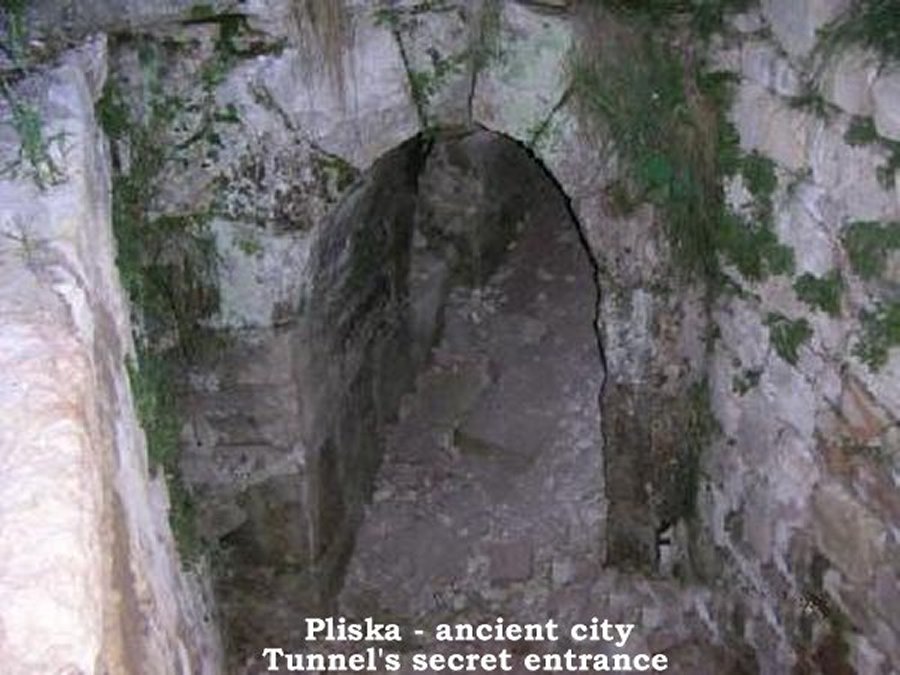Pliska: Ancient City Ahead Of Its Time With Secret Underground Tunnels, Sewage And Heating Systems
A. Sutherland - AncientPages.com - Ancient city of Pliska was once the capital of the First Bulgarian Empire after the Ancient Bulgars shifted the center of their state from the lands of the so called Old Great Bulgaria, located north of the Black Sea to the wider Lower Danube region in the second half of the 7th century AD.
Pliska - very old city with a fascinating history - was the capital in 680-893 AD. Archaeological discoveries have confirmed that Pliska was settled much earlier than previously thought.
Before the arrival of the Ancient Bulgars, the area is known to have been settled by Slavs.
Not long ago, archaeologists uncovered a network of ancient secret tunnels under Pliska. Interestingly, one of the entrances to the secret tunnels, is only constructed of wood, with the planks, well cut and covering exactly the entrance to the tunnel.
Despite that the structure survived a fire since early Medieval times.
Researcher Mariela Inkova explained that "the wooden boards finish at the doors that served as a paneling and they are just cut in line with the width of inputs, you can see the gaps between well-ordered leveling boards that end up vertical doors of this entrance.
However, these ancient boards are a clear proof of the burning of Pliska by the armies of the Byzantine emperor Nikephoros I who conquered the city in 811 AD.
 Nikephoros I - Byzantine Emperor from 802 to 811 AD, killed in the Battle of Pliska. Image via Britannica
Nikephoros I - Byzantine Emperor from 802 to 811 AD, killed in the Battle of Pliska. Image via Britannica
The capital of Pliska was constructed in an area of 23 square kilometers, and had a moat and ramparts surrounding the outer walls. These were constructed with stability, longevity, and indispensable strategic details.
An important structure of Pliska was the fortified residency of the Bulgarian Khans and
crown princes - the so-called Inner Town. First wooden palace buildings were later rebuilt with bricks, chiseled stones and mortar.
In 811 Pliska was conquered by the army of Byzantine Emperor Nikephoros I. Refusing to take any chances against Byzantine invaders, even the inner walls of the capital were over 2.5 meters thick, and were built to about 12 meters high.
Pliska was ahead of the neighbors in plenty of ways - the city had a functioning sewage system that was modeled on Roman sewers, and the heating systems throughout the entire city ensured that the people were kept safe and warm throughout the harsh winters. Fortress walls surrounded the city, both inner and outer, and at each corner there was a cylindrical-shaped tower for lookouts and nightly watchmen.
What was the purpose of the Pliska's tunnels? Could they serve as a shelter, a protection against attacking armies of enemy? The underground network of the city's tunnels has certainly much more to reveal.
Written by A. Sutherland - AncientPages.com Staff Writer
Copyright © AncientPages.com All rights reserved. This material may not be published, broadcast, rewritten or redistributed in whole or part without the express written permission of AncientPages.com.
Expand for referencesReferences:
J. Henning, Post-Roman Towns, Trade and Settlement in Europe and Byzantium
P. Sophoulis, Byzantium and Bulgaria, 775-831
More From Ancient Pages
-
 Proof Of Superior Ancient Technology – Found In All Four Corners Of The World
Ancient Mysteries | Mar 19, 2014
Proof Of Superior Ancient Technology – Found In All Four Corners Of The World
Ancient Mysteries | Mar 19, 2014 -
 Tyrannical Tarquin The Proud: The Seventh And Last King Of Rome Was Banished
Featured Stories | Jan 28, 2020
Tyrannical Tarquin The Proud: The Seventh And Last King Of Rome Was Banished
Featured Stories | Jan 28, 2020 -
 Huge Ancient Hydraulic System Built By The Liangzhu Culture May Be World’s Oldest And Predate Mesopotamian Water Systems
Ancient Technology | Dec 9, 2017
Huge Ancient Hydraulic System Built By The Liangzhu Culture May Be World’s Oldest And Predate Mesopotamian Water Systems
Ancient Technology | Dec 9, 2017 -
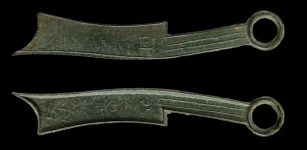 Scientists Decipher 2,300-Year-Old Chemistry Formulas Revealing Ancient Metallurgy Was More Complex Than Previosuly Thought
Ancient Technology | Aug 10, 2022
Scientists Decipher 2,300-Year-Old Chemistry Formulas Revealing Ancient Metallurgy Was More Complex Than Previosuly Thought
Ancient Technology | Aug 10, 2022 -
 Blame The Neanderthals For Your Lower Back Pain – Scientists Say
Archaeology | Mar 8, 2022
Blame The Neanderthals For Your Lower Back Pain – Scientists Say
Archaeology | Mar 8, 2022 -
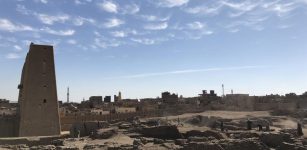 Well-Preserved Settlement Dated To 2,400 BC Unearthed At Tell Edfu, Egypt
Archaeology | Feb 8, 2018
Well-Preserved Settlement Dated To 2,400 BC Unearthed At Tell Edfu, Egypt
Archaeology | Feb 8, 2018 -
 Biblical Events Confirmed: The Jerusalem’s Wall That Nehemiah Built
Biblical Mysteries | Mar 19, 2014
Biblical Events Confirmed: The Jerusalem’s Wall That Nehemiah Built
Biblical Mysteries | Mar 19, 2014 -
 The Faery Grail Of Hospitality And Accord- The Forgotten Story – Part 1
Ancient Mysteries | Sep 25, 2019
The Faery Grail Of Hospitality And Accord- The Forgotten Story – Part 1
Ancient Mysteries | Sep 25, 2019 -
 Legend Of The Four Dragons That Disobeyed The Jade Emperor And Gave China Water
Chinese Mythology | Feb 22, 2019
Legend Of The Four Dragons That Disobeyed The Jade Emperor And Gave China Water
Chinese Mythology | Feb 22, 2019 -
 On This Day In History: Munich Agreement Was Signed – On Sep 30, 1938
News | Sep 30, 2016
On This Day In History: Munich Agreement Was Signed – On Sep 30, 1938
News | Sep 30, 2016 -
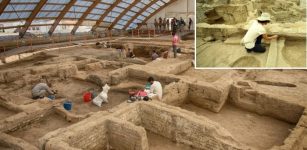 Unique And Unusually Large 8000-Year-Old Building Discovered At Çatalhöyük Site, Turkey
Archaeology | Sep 26, 2022
Unique And Unusually Large 8000-Year-Old Building Discovered At Çatalhöyük Site, Turkey
Archaeology | Sep 26, 2022 -
 Mysterious White Chinese May Be Related To Ancient Roman Soldiers – Did Marcus Crassus’ Army Settle Down In The Gobi Desert?
Civilizations | Dec 29, 2017
Mysterious White Chinese May Be Related To Ancient Roman Soldiers – Did Marcus Crassus’ Army Settle Down In The Gobi Desert?
Civilizations | Dec 29, 2017 -
 Lofn ‘Matchmaker’ – Norse Goddess Of Forbidden Marriages Of People Who Wish To Be Loved And Search For Partners
Featured Stories | Mar 25, 2021
Lofn ‘Matchmaker’ – Norse Goddess Of Forbidden Marriages Of People Who Wish To Be Loved And Search For Partners
Featured Stories | Mar 25, 2021 -
 How Did 20th-Century Philosophers Explain Ghosts And Other Spooky Subjects?
Featured Stories | Nov 8, 2024
How Did 20th-Century Philosophers Explain Ghosts And Other Spooky Subjects?
Featured Stories | Nov 8, 2024 -
 Dresden Codex – Probably The Oldest And Best Preserved Book Of The Maya
Ancient History Facts | Jun 24, 2016
Dresden Codex – Probably The Oldest And Best Preserved Book Of The Maya
Ancient History Facts | Jun 24, 2016 -
 Escape Tunnel From Crusader Citadel In Tiberias To Sea Of Galilee – Discovered
Archaeology | Jun 15, 2017
Escape Tunnel From Crusader Citadel In Tiberias To Sea Of Galilee – Discovered
Archaeology | Jun 15, 2017 -
 Pharaoh Psusennes I Buried In The Silver Coffin Inlaid With Gold
Civilizations | Jul 16, 2016
Pharaoh Psusennes I Buried In The Silver Coffin Inlaid With Gold
Civilizations | Jul 16, 2016 -
 Chinampas: Artificial Islands Created By The Aztecs To Improve Agriculture
Ancient History Facts | May 17, 2016
Chinampas: Artificial Islands Created By The Aztecs To Improve Agriculture
Ancient History Facts | May 17, 2016 -
 Tecumseh: Native American Mystic, Warrior, Hero And Military Leader Of The Shawnee
Featured Stories | Jun 3, 2016
Tecumseh: Native American Mystic, Warrior, Hero And Military Leader Of The Shawnee
Featured Stories | Jun 3, 2016 -
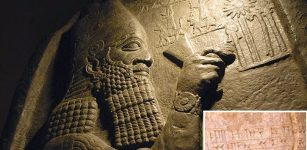 Clay Tablets Of Assyrian ‘King Of The World’ Esarhaddon Found Beneath Biblical Tomb Of Jonah
Archaeology | Mar 1, 2018
Clay Tablets Of Assyrian ‘King Of The World’ Esarhaddon Found Beneath Biblical Tomb Of Jonah
Archaeology | Mar 1, 2018

